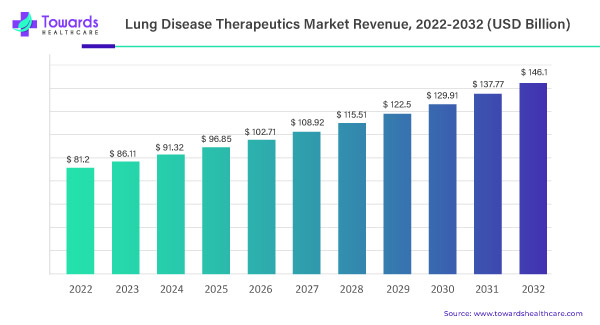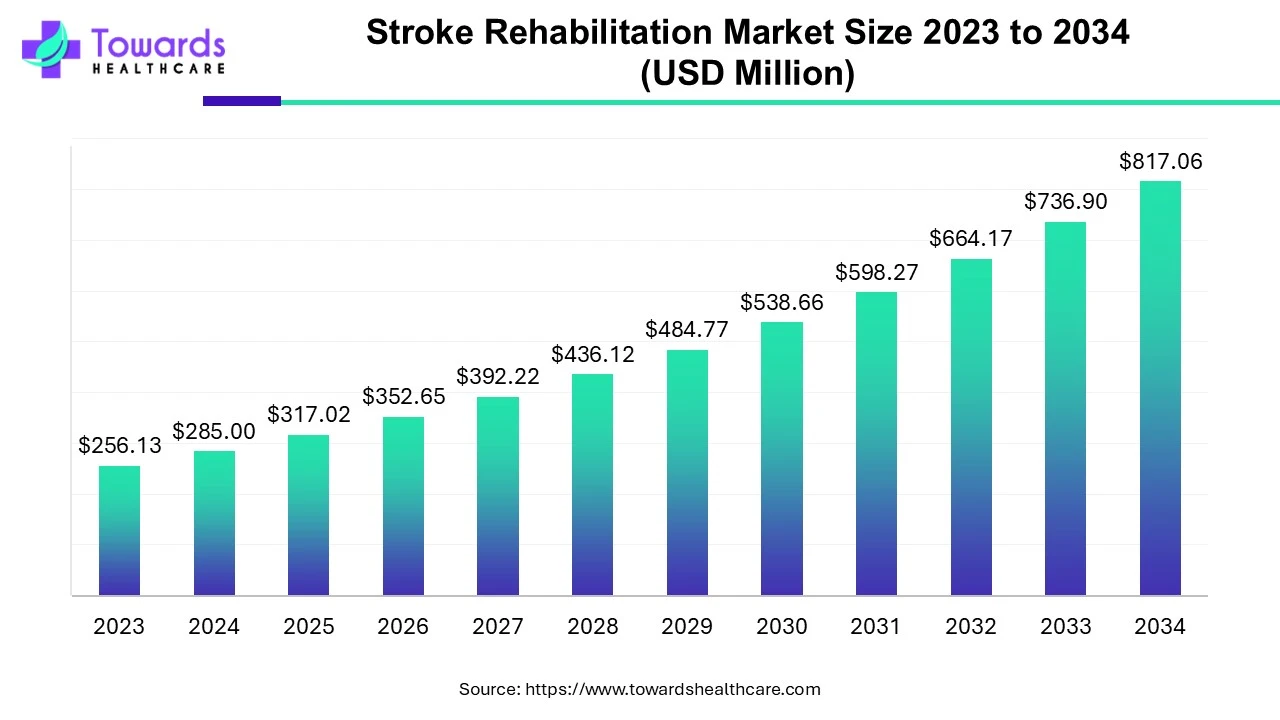In the realm of healthcare, the global lung disease therapeutics market has witnessed an impressive ascent, reaching a substantial USD 81.2 billion in 2022. Projections indicate that this upward trajectory is far from over, with the market poised to reach an estimated USD 146.1 billion by 2032. What propels this remarkable growth? The driving forces lie in the continuous advancement of targeted and personalized therapies, coupled with the escalating prevalence of associated diseases.

Navigating Progress: The Unveiling Landscape of Lung Disease Therapeutics Market
1. Targeted and Personalized Therapies: A Paradigm Shift
The landscape of lung disease therapeutics market is undergoing a paradigm shift, primarily fueled by advancements in targeted and personalized therapies. These innovations are not only reshaping treatment approaches but also contributing significantly to the market’s expansion. As science continues to unlock the intricacies of lung diseases, tailored therapeutic interventions are becoming increasingly prevalent, promising more effective outcomes for patients.
2. Prevalence of Associated Diseases: A Growing Concern
The surge in the prevalence of diseases associated with lung conditions has become a prominent global concern. From chronic respiratory disorders to pulmonary infections, the expanding spectrum of associated diseases is a key factor driving the demand for advanced therapeutics. The market responds to this growing need, positioning itself as a vital player in the global healthcare landscape.
Asthma symptoms are prevalent in approximately 1 in 10 children globally. According to the Global Asthma Network (GAN) Phase I 2022 findings, the overall prevalence of current asthma symptoms was 9.1% among children, 11.0% among adolescents, and 6.6% among adults.
The lung disease therapeutics market is witnessing significant growth due to the increasing prevalence of respiratory disorders, including chronic obstructive pulmonary disease (COPD), asthma, cystic fibrosis, and pulmonary arterial hypertension (PAH). These diseases pose a substantial burden on global healthcare systems and require effective therapeutic interventions to manage symptoms, improve patient outcomes, and enhance quality of life.
The market encompasses various therapeutic approaches, including bronchodilators, corticosteroids, targeted therapies, monoclonal antibodies, and gene therapies. These treatments aim to alleviate symptoms, reduce inflammation, restore lung function, and prevent disease progression. The increasing awareness about respiratory health, advancements in diagnostic techniques, and the development of novel treatment options are driving market growth. The rising geriatric population, growing tobacco smoking prevalence, and environmental factors such as air pollution contribute to the high demand for lung disease therapeutics.
Advancements in Targeted therapies and Personalized Medicine
Advancements in targeted therapies and personalized medicine are major lung disease therapeutics market drivers. Traditional treatments for lung diseases often focus on symptom management and broad-spectrum therapies. However, the emergence of targeted therapies has revolutionized the treatment landscape, enabling more precise interventions based on individual patient characteristics. The rising prevalence of lung diseases is creating the need for advanced therapeutic interventions thereby augmenting the growth of the lung disease therapeutics market. For instance, according to the Forum of International Respiratory Societies (FIRS)
- Approximately 65 million individuals are affected by COPD (chronic obstructive pulmonary disease), with 3 million deaths occurring annually as a result of the condition.
- Additionally, lung cancer claims the lives of 1.6 million individuals each year.
- The global prevalence of asthma stands at 33 million people, while asthma affects approximately 14% of children worldwide.
- Tragically, around 4.2 million deaths occur annually due to exposure to outdoor air pollution.

According to the American Lung Association, in the year 2020, a total of 12.5 million adults, which accounts for 5.0% of the population, reported being diagnosed with COPD, which includes chronic obstructive pulmonary disease, chronic bronchitis, or emphysema.
Targeted therapies involve the use of drugs that specifically target key molecular pathways and cellular mechanisms involved in lung diseases. For example, in the case of non-small cell lung cancer (NSCLC), targeted therapies such as tyrosine kinase inhibitors (TKIs) are designed to block specific genetic mutations or proteins that drive tumor growth. These therapies offer improved treatment outcomes and fewer side effects compared to traditional chemotherapy.
Personalized medicine approaches in lung disease therapeutics market utilize genetic testing and biomarker analysis to identify patients who are more likely to respond to specific treatments. For instance, genetic testing can identify patients with EGFR mutations in NSCLC who are more likely to respond to EGFR-targeted therapies. By tailoring treatment strategies based on individual patient characteristics, personalized medicine optimizes therapy selection, improves treatment efficacy, and minimizes adverse effects.
The development of targeted therapies and personalized medicine in lung disease therapeutics market is supported by advancements in molecular diagnostics, genomics, and proteomics. These technologies enable the identification of disease-specific biomarkers, genetic variations, and molecular signatures that inform treatment decisions. Furthermore, the integration of artificial intelligence (AI) and machine learning algorithms enhances the analysis of complex molecular data, facilitating the discovery of novel therapeutic targets and personalized treatment regimens.
Catalysts of Growth: Decoding Market Dynamics
1. Advancement in Targeted and Personalized Therapies
The heartbeat of the lung disease therapeutics market is the continuous advancement in targeted and personalized therapies. As research and development efforts push the boundaries of innovation, the market responds with a diversified array of therapeutic options. This evolution is not only instrumental in meeting current healthcare challenges but also prepares the market for future demands.
2. Escalating Prevalence of Associated Diseases
The prevalence of diseases linked to lung health is a catalyst for sustained market growth. Chronic obstructive pulmonary disease (COPD), asthma, and interstitial lung diseases are among the conditions contributing to the rising demand for therapeutics. The market, in turn, positions itself as a critical player in addressing the evolving healthcare needs associated with these conditions.
The Increasing Focus on Inhalation Therapies
The increasing focus on inhalation therapies and respiratory drug delivery systems is another major driver in the lung disease therapeutics market. Inhalation therapies offer several advantages over other routes of drug administration, including targeted delivery to the lungs, reduced systemic side effects, and improved patient convenience and compliance. Inhalation therapies involve the use of inhalers, nebulizers, and dry powder inhalers (DPIs) to deliver medications directly to the lungs. These devices enable the efficient delivery of bronchodilators, corticosteroids, and other respiratory medications, providing localized treatment and rapid symptom relief.
The development of advanced inhalation technologies and drug delivery systems has expanded treatment options for lung diseases. For instance, the introduction of metered-dose inhalers (MDIs) with spacers has improved medication delivery and reduced the need for hand-lung coordination, benefiting patients with limited dexterity or difficulty in using traditional inhalers.
Additionally, the emergence of smart inhalers, integrated with sensors and connectivity features, has revolutionized respiratory care. Smart inhalers can monitor medication usage, provide reminders, track symptoms, and transmit data to healthcare providers. These devices facilitate better disease management, adherence to treatment plans, and remote patient monitoring, ultimately leading to improved outcomes.
Inhalation therapies and respiratory drug delivery systems are particularly crucial in the management of chronic respiratory conditions like asthma and COPD. These diseases often require long-term maintenance therapy and quick-relief medications. Inhalation therapies offer precise dosing, rapid onset of action, and the ability to adjust dosage based on individual needs, providing optimal disease control and symptom management. Furthermore, the ongoing research and development in inhalation technologies aim to enhance drug delivery efficiency, reduce the frequency of dosing, and improve patient convenience. Novel inhaler designs, formulations, and drug combinations are being explored to overcome the limitations of current inhalation devices and optimize treatment outcomes.
Impact of High Cost of Therapies and Limited Availability
Despite the growth prospects, the lung disease therapeutics market faces significant challenges, with one major restraint being the high cost of therapies and limited accessibility. Many advanced targeted therapies and biologics used in the treatment of lung diseases come with high price tags. The development of these therapies involves extensive research, clinical trials, and regulatory processes, which contribute to their elevated costs. Additionally, the limited patient population for certain rare lung diseases and the need for specialized manufacturing processes further contribute to the high prices of these therapies.
The high cost of lung disease therapeutics market poses challenges in terms of affordability, reimbursement, and access to treatment, particularly in low- and middle-income countries. Patients may face financial barriers in accessing these therapies, limiting their ability to benefit from the latest advancements in treatment options.
The pricing and reimbursement policies vary across different healthcare systems and countries, further impacting the accessibility of lung disease therapeutics. The process of obtaining reimbursement coverage for new therapies can be complex and time-consuming, leading to delays in patient access and limited availability in certain regions. Additionally, the lack of healthcare infrastructure and trained healthcare professionals in some regions can hinder the effective delivery of lung disease therapeutics. Limited access to diagnostic facilities, specialized clinics, and healthcare providers with expertise in respiratory care can result in underdiagnosis, inadequate treatment, and suboptimal disease management.
Addressing the high cost and limited accessibility of lung disease therapeutics requires a comprehensive approach involving collaboration between healthcare stakeholders, policymakers, and pharmaceutical companies. Efforts should be made to streamline pricing and reimbursement processes, ensure equitable access to innovative therapies, and promote affordable generic alternatives.
Geographical Landscape
North America, specifically the United States, holds a significant share in the lung disease therapeutics market. The region’s dominance can be attributed to factors such as a high prevalence of lung diseases, well-established healthcare infrastructure, robust research and development activities, and favorable reimbursement policies. The United States has a considerable burden of respiratory diseases, including COPD, asthma, and lung cancer. The availability of advanced diagnostic tools, a well-developed healthcare system, and a favorable regulatory environment contribute to the growth of the lung disease therapeutics market in the country.

Projections and Trajectories: A Glimpse into the Future
1. Projected Market Size by 2032
The projected market size of USD 146.1 billion by 2032 signifies not just financial growth but an enhanced capability to address the complex challenges posed by lung diseases. As the market expands, it becomes a cornerstone of healthcare, offering innovative solutions and paving the way for a healthier global population.
2. CAGR of 6.1%: Sustaining Momentum
The compound annual growth rate (CAGR) of 6.1% from 2023 to 2032 is a testament to the sustained momentum propelling the lung disease therapeutics market forward. This consistent growth rate mirrors the industry’s resilience and its ability to adapt to evolving healthcare landscapes.

Key Market Players:
- Johnson & Johnson
- Amgen Inc.
- AstraZeneca
- Boehringer Ingelheim
- Pfizer Inc.
- Allergan Inc.
- Bristol-Myers Squibb Company
- Eli Lilly and Company
- Hoffmann-La Roche
- Merck & Co
- Teva Pharmaceutical Industries Ltd.
- AbbVie, Inc.
- Novartis AG
Market Segments:
By Disease Type
- Asthma
- Lung Cancer
- Chronic Obstructive Pulmonary Disease (COPD)
By Drug Class
- Corticosteroids
- Bronchodilator
- Antimicrobial
- Alkylating Agents
- Mucolytics
By Molecule Type
- Small molecules
- Biologics
By Treatment Type
- Chemotherapy
- Immunotherapy
- Targeted Therapy
- Radiation Therapy
By Distribution Channel
- Online
- Hospital
- Retail
By Geography
- North America
- Europe
- Asia-Pacific
- Latin America
- Middle East and Africa
In Conclusion: Redefining Respiratory Health
As the global lung disease therapeutics market embarks on a journey of substantial growth, it redefines the landscape of respiratory health. With advancements in targeted therapies and a commitment to addressing the rising prevalence of associated diseases, the market emerges as a pivotal player in fostering a future where respiratory health is prioritized, personalized, and innovative. The journey unfolds, promising a breath of fresh air for the global healthcare ecosystem.


